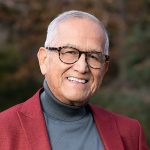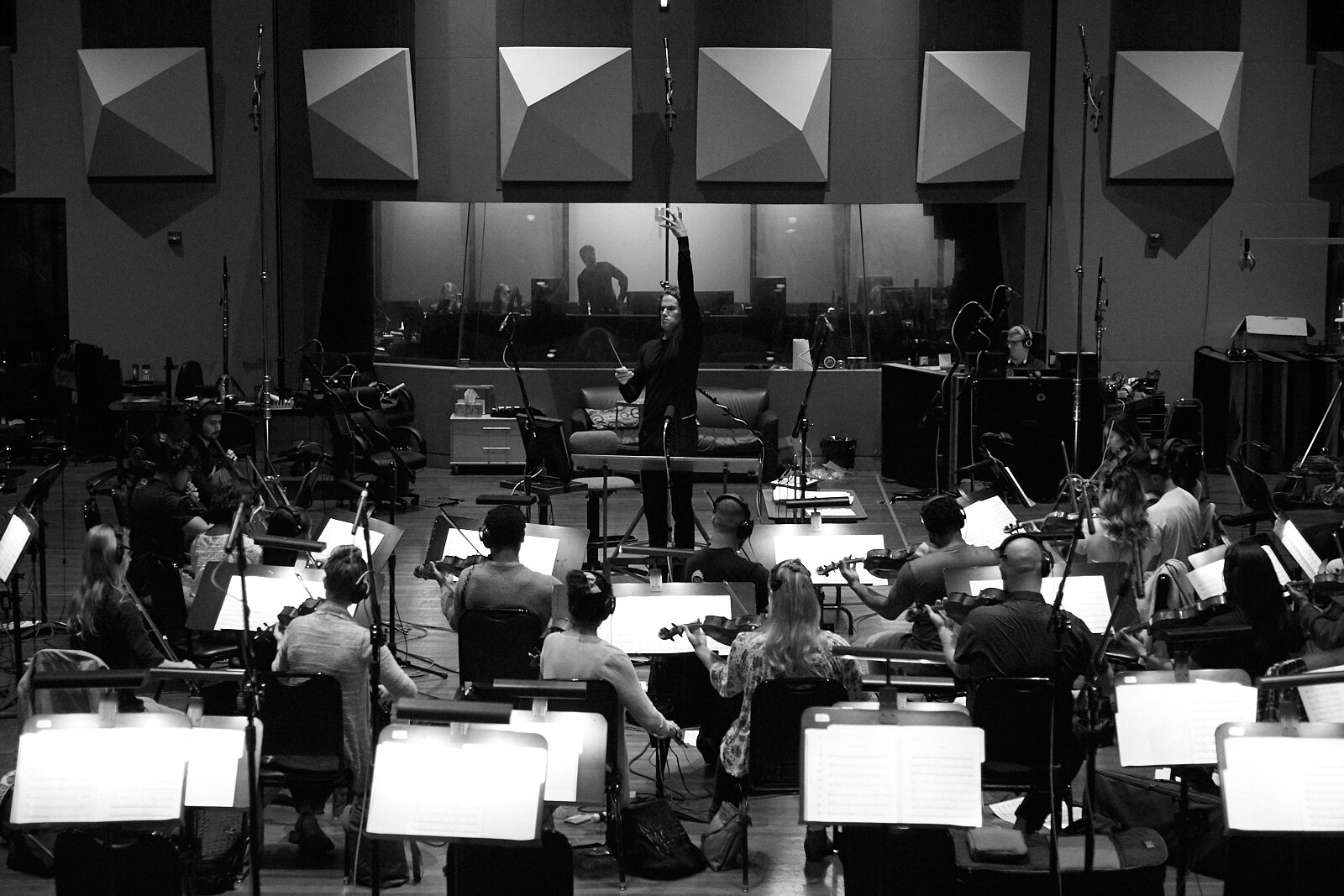
Steve Hackman – Courtesy of Indianapolis Symphony Orchestra. Used with permission.
Described as a “multi-hyphenate music powerhouse and visionary producer,” Steve Hackman is an intrepid composer, conductor, producer, DJ, arranger, songwriter, singer, and pianist. Proud of a history with the Indianapolis Symphony Orchestra that started in 2010, Hackman is making his return to the city to lead the orchestra that helped him launch his career as a musician who creates innovative fusions.
On Wednesday, Jan. 25, at 7:30 p.m., at the Hilbert Circle Theatre, Hackman will conduct his daring composition “Beethoven X Coldplay” for the ISO’s second concert in their Uncharted Series this season. “Beethoven X Coldplay” is the merging of two musical icons, pairing two composers who deal with similar themes and revealing how much the music of these artists has in common. The performance will transform Beethoven’s “Eroica” into an oratorio, folding the melodies and lyrics of the British rock band Coldplay into the original Beethoven, and combining their content and context.
Recently, I had the opportunity to chat by Zoom with Hackman who was calling from St. Moritz, Switzerland, where he said he was writing, skiing, and spending time with a friend. Below is an edited transcript of our conversation.
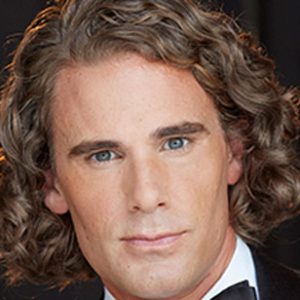
Steve Hackman – Courtesy of Indianapolis Symphony Orchestra. Used with permission.
What does all music share?
In the case of Beethoven and Coldplay, it is such universal music. They confront the big themes. The big humanist themes of love and loss and joy triumph and failure, and they express it somehow so distinctly in music. That is why I sought to combine them.
When did you write it?
I wrote it in 2015 and revised it in 2020 during the pandemic lockdown.
Are you constantly working on new pieces?
I am. Generally speaking, I will write a new fusion every year, and I will spend the rest of my time writing my own music, collaborating with artists, with choreographers, writing ballets, film music, etc. My task in all of these specific pairings is to identify what they all have in common. I often say these days: you can find similarities between almost anything, because it is all the same twelve notes, but just because you can combine them doesn’t mean that you should. So I am always looking for a compelling reason to fuse them and some sort of context that is going to enable me to show something new, through the lens of another, or reflect the light off the one in a slightly different way that gives the viewer a different appreciation of it.
Tell me about your relationship with the ISO. How did it develop?
It began in 2010. Time for Three was in residence with the ISO at that time. I had gone to school with them, and they are artistic brothers of mine. The ISO had a series called Happy Hour back then, and the mission was to engage with Millennial audiences. The administration of the orchestra asked Time For Three, “Would you want to take over this Happy Hour Series? Because you seem to be really kind of good at engaging new audiences and young audiences.” Time for Three said yes, we’d love to do that, but we need our friend and colleague Steve Hackman to come and be the conductor and the arranger, because all the music needed to be written. So that was the beginning. I had several years in residence with Time for Three and for the last five or six, since Time for Three moved on, I have been with the ISO. It has been just amazing.
Have all your hybrid compositions been performed in that series?
Not all of them, but many of them have premiered with the ISO, which is one reason why the relationship has been so special. The ISO was my reentry into the classical music world. I studied at Curtis and had done the whole classical thing, and after graduating began conducting orchestras. I was in my early twenties at the time, and I wasn’t finding a way in the classical world to be as creative as I wanted to be. I didn’t see that landscape as one providing those opportunities for me to express what I wanted to artistically to people my own age. The ISO and Time for Three offered that opportunity to kind of rewrite the script, as far as where we could take this music, so all these fusion techniques were a result of that. It was a laboratory and a workshop for me. They gave us the keys and said create and try to push this as far as you can, so that is what we did, and it was a beautiful time.
Are you finding more interest in your work from music directors?
In all of the guest conducting I do with orchestras, and all the relationships I have through this kind of programming, this hybrid programming between the classical and the popular is a new lane. It’s something that your typical music director in an orchestra is not too familiar with, but most are aware that we need this kind of programming, so I find a lot of support from those music directors, which is great.
Would you consider yourself a pioneer in this work?
I think it is a little self-congratulatory to say that; however, just from a factual standpoint, Time for Three and I got this started, and I have been pushing it forward. There is not a lot of it going on, so I would, indeed, consider myself a pioneer.
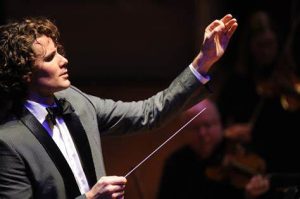
Steve Hackman – Courtesy of Indianapolis Symphony Orchestra. Used with permission.
Are you mentoring any young composers and/or conductors who are interested in your work?
Informally, there are a lot of artists- and this has emerged in the last couple of years- who are younger, from the next generation, who graduated from school and have seen my work as representative of a new landscape and ideology. They have found me either on social media or at concerts and have said, “Here’s what I do. I am interested in what you are doing, and can we talk?” And that is pretty exciting to think- that this could influence a whole new generation. It’s pretty thrilling to consider what is going to come next. I have always said: the fusion shows are just one example of where this can go. I want to continue to find new ways to reconceptualize this music and reengage new audiences and develop and push classical music forward. I can’t wait to see what comes after me.
Are you invited to music schools to teach or do workshops?
I have done very little of that. I would say because the concert and writing schedule is so busy. But it’s not as if there are a bunch of invitations outstanding that we are turning down. I also think it is so new that they may not even be aware of it yet. I think it will come. I have had conversations. The director of the Curtis Institute (Hackman’s alma mater) and I are always talking, and he would love for me to come in, but it is still a little outside of what they do. And, just like with some orchestras, there is not a simple, easy slot for this to fit into. So, it takes thinking outside the box to implement.
Has the ISO been able to track newer, younger audience members your work has attracted?
Yes, I would say there is tracking. They can easily access how many new households to file come for concerts and how many people come through the doors. There is a lot of historical data here. Since we’ve been doing this for ten years, there are people now in their mid-twenties who started to come to Happy Hour when they were teenagers who have been introduced to classical music through the work we have been doing. It is pretty special.
I would think that there is demand for the programming you are creating from orchestras seeking to attract newer and younger audiences, is there not?
It’s up considerably, in the last few years, I would say. It seems like we are at an inflection point. The schedule is pretty filled up. I was just talking to my agent earlier today, and of all the concerts this year, nearly all of them have been either sold out or at 90%, so that’s very exciting – including the ISO. We classical musicians need to find ways to stay relevant, engage, and inform audiences about what we are doing and create access points and all those things. These programs are designed to do that.
You have faced criticism from critics, even one who accused you of “defacing” classical music. What is your response?
To be honest with you, Tom, my concerts aren’t reviewed very often. I think, as it stands, music writers, especially classical music writers, are becoming more and more scarce, and the capacity to send out journalists to review is just not what it used to be. So if orchestras are going to send out for reviews, generally speaking it’s going to be for their marquee classical series or a pop concert with a big artist. But generally, it’s their classical concerts that get reviewed, because that’s where they’re putting all their resources, and I am not trying to say they are not as equally invested or involved in other segments of their programming, but classical concerts tend to be their marquee moments, so I generally don’t get reviewed too often. However, the stance taken by that journalist you quoted is representative, I think, of maybe a small but vocal group within classical music, especially among classical musicians themselves, that are pretty entrenched and understandably pretty traditionalist. They are purists, and for good reason.
Sometimes I am not sure that someone taking that stance understands how much I love this music in order to do what I do with it. Like in the case of “Beethoven X Coldplay,” how well I need to know every single note Beethoven wrote and how well I need to know who he was at that time as a 33-year-old. I need to love it as much if not far more, I think, than those artists who are purists that are saying you are defacing this music or whatever it is. I get their position because I am one of them, too. I don’t think the “Eroica” symphony needs any improving. That is not what I am trying to say, obviously. It is perfect. It is unbelievable. It’s one of the best things ever written. But just offering a different look at it, just like any remix of any song, does not supplant the original. Over time, I think there have been people who have been won over. More than that, I encourage the conversation. Because, once again, I am one of them. That may sound confusing or backwards, but I just get where they are coming from.
Our mutual friend, concert pianist, ISO program notes writer and teacher Marianne Tobias suggested I ask you this next question. As a conductor, how do you use your left hand which a writer once described as “beautiful, flexible and undulating.”
As a conductor, everything you do physically has the potential to communicate effectively to the orchestra or runs the risk of being a distraction. That goes for your eyes, your mouth, your face, and your general disposition, just as much as your hands. So, when conducting, our right hand, of course, is keeping time and the beat and it is the most important. That is what players need to see….it needs to be precise; it needs to be exact; it needs to show them exactly where they are. But then you have this whole other hand. I have it has evolved for me over time. I think when most conductors start their left hand is just mirroring their right hand and you learn to use it to be specific and expressive. I think for a while my left had got a little out of control. I have big hands and long arms, so everything is magnified and amplified when the orchestra sees something, so I have worked hard to be as specific as possible with the left hand and when it is not needed, put it somewhere where it is out of the way. (laughs)
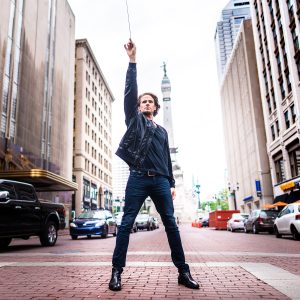
Steve Hackman – Courtesy of Indianapolis Symphony Orchestra. Used with permission.
As a person of color, I appreciate your efforts at making classical music more inclusive by fusing classical music with hip-hop and collaborating with artists such as Kanye West. Why is representation important?
I think, first of all, it’s such an important conversation and important to take action that is going to have an impact and that is going to invite new communities and new people into the concert hall. I remember my days as a young assistant conductor. An orchestra would be programming for their Martin Luther King Memorial concert. I would look at the programming, and they would bemoan the fact that more people of color or more black people were not attending these concerts, and I am looking at the programming and thinking, “You are not doing a good job of making them feel welcome.” You might start by asking yourself the question, “What would an ideal concert hall experience be like for them?” I think there are some people in the classical world who have no idea that the concert hall can feel like a hostile or unwelcome place for a person of color. That idea is actually foreign and so strange to a lot of people in the classical world. They do not even understand that. That tells you a lot. So we need to have that conversation.
Do you feel good about promoting diversity in the world of classical music?
To meet audiences, people who are coming through the doors for the first time, who are telling me, “We never thought this was a safe place for us and thank you. We never thought we would see something like this happening with this orchestra. Thank you.” To see how moved they were and that they felt welcomed and that they had such a potentially transformative experience, that’s what it is all about.
What are your thoughts about Indy in general?
It is incredibly special to me because that’s where this all started, and the ISO has seen me evolve from when I was a kid who did not know what he was doing when I started with Time for Three. We had the ability to get up there and do something, but we were just scratching the surface in the beginning and just throwing things at the wall and just figuring this out. So the ISO has been part of that journey every step of the way – from planting the seeds of it and being the genesis of it, to now sowing those seeds and taking it all over the world. Now, when I come back to Indy, it’s fun and I feel like those musicians feel an ownership over this music. It’s very special to me.
For tickets and information about “Beethoven X Coldplay” visit indianapolissymphony.org.
,





